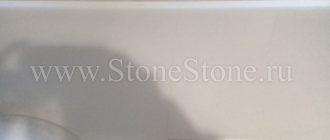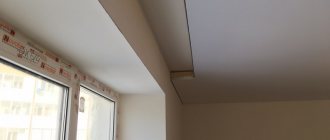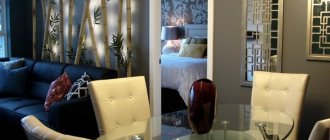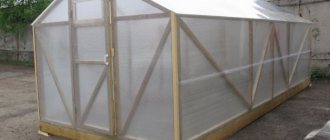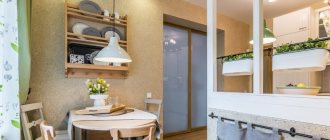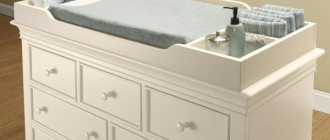It’s not for nothing that flexible stone is considered the material of the future. Completely eco-friendly and natural. It is easy to work with and has a number of advantages. The flexible stone is made from sandstone, which is also the front side of the material. It allows you to create interesting design projects.
The cost of flexible stone varies from 800 to 5 thousand per square meter. For example, a flexible stone of the Flexstone Premium brand, Germany, costs 7,500 for a roll measuring 2,700 by 1,200. And for the Delap material, Hungary, they ask for 1,170 rubles for a sheet of 500 by 500.
The stone itself consists of fiberglass, polymer and sandstone. The sandstone is cut, the surface is polished and attached to the base. Afterwards, the finished product is dried.
How the material is made
Flexible stone is quite expensive, this is due to the manufacturing technology of the material; the process is completely manual. A fabric base is attached to the sandstone. The fabric is torn off, as a result, part of the sandstone remains on the canvas. This product has a sandstone color and finish. Thanks to the sandstone layer, the product is durable and fireproof. It is quite elastic, which is why it got the name “flexible stone”.
What kind of material is this?
Flexible stone is mistaken for a plastic-based material. But that's not true. A flexible stone, the imperfections of which are difficult to notice, is a thin slice of natural sandstone transferred to a flexible fiberglass canvas used as a base.
It is presented on the market in the form of wallpaper, sold in rolls from 2 to 2.8 meters, tiles and veneers. Using such material and mastering the subtleties of working with it, you can achieve an aesthetically unsurpassed result.
It is known that all building materials have their own characteristics: advantages and disadvantages, and flexible stone is no exception. Its shortcomings are subtle, but they still exist. Let's start with a minor imperfection, after which we will consider in detail all the positive qualities.
The main pros and cons of the material
The main advantages of the material:
- Moisture resistance.
- Lightweight and elastic material.
- Eco-friendly and natural.
- Durable.
- Not fussy about maintenance.
It gained wide popularity relatively recently and was immediately loved by many. Interiors where flexible stone is used look interesting and unusual. The technology for laying flexible stone is similar to wallpapering.
The walls need to be cleaned, leveled, glue applied to the wall and a flexible stone applied. The subsequent strip should be applied with preheated edges.
This is the main difference from working with wallpaper. The edges must be heated so that the seam is not noticeable. Due to its structure, flexible stone is durable and light. It is very flexible during installation and easily takes the desired shape when heated. The material also has a beautiful appearance.
Let us highlight several main disadvantages of the material:
High price
If you buy coating from a well-known supplier with quality certificates, then the price per square meter starts from 1,300 rubles. That's why many craftsmen come up with homemade products.
It is up to you to decide whether to buy a flexible stone at this price. After all, the price of this material is close to the cost of natural stone. But unlike flexible stone, decorating a room with natural stone is much more difficult and expensive.
Before laying flexible stone, you need to prepare the surface
It should be completely flat. This requires additional preparation time and certain costs.
Large counterfeit market
Yes, of course, such products are much cheaper, but in terms of their characteristics they are much inferior to the original.
Instead of epoxy resin, these products use glue. This has a bad effect on the elasticity of the material. This can lead to the formation of a large number of cracks during operation. Stone chips begin to crumble from the edges.
And don’t forget about caring for flexible stone. In order for it to serve you for a long time, you need to wipe the material regularly. If there is a large accumulation of dust, you can go through it with a vacuum cleaner.
Advantages of flexible stone in the interior of a cottage
- Decorating the walls of various rooms
Flexible stone can be used to decorate the wall either entirely or partially.
It can be laid on a surface of complex shape with numerous roundings and bends. In this case, the structure of the stone, unlike monolithic sandstone, is not damaged. Flexible stone has a wide choice of patterns and colors, so it is suitable for finishing various rooms and realizing any design fantasies. Flexible stone harmonizes well with surfaces made of related, natural materials. It is used for finishing the walls of large halls and for cladding columns.
https://www.youtube.com/watch?v=OlJgclEZpJY
Decorative painting on wild stone is an original solution.
Facing artificially created structures that imitate natural mountainous terrain with flexible stone allows you to create an atmosphere of complete presence.
Finishing facades with flexible stone is a good solution for country cottages.
The interior or facade of a building decorated with flexible stone has high aesthetics and excellent decorative properties. Natural material allows you to create a cozy, comfortable atmosphere.
rmnt.ru
20.05.15
The uniqueness of flexible stone in the interior of a cottage is undeniable. They can easily design both straight and even surfaces and complex structures in the form of intricate columns, arched door and window openings, and steps.
If desired, the buyer can order materials according to his own individual sizes. Modern cottage interior - not only a specialist can work with flexible stone. For cutting, regular scissors or standard construction knives are quite suitable. Soft stone is not susceptible to cracking during processing.
The use of flexible stone in the interior of cottages and the decoration of buildings and premises has become widespread in Russia. It is used not only for interior design
Often flexible stone is used for finishing:
- fireplaces,
- swimming pools,
- bathrooms,
- saunas,
- stairs,
- sculptural compositions,
- imitation of various natural landscapes.
Such a versatile use of this decorative material is explained by its properties. In addition to the fact that it is absolutely natural and harmless, flexible stone is resistant to fire and high temperatures (up to 650 degrees Celsius), and also has high moisture resistance.
External finishing of cottages with flexible stone is beneficial due to its resistance to low temperatures (up to -30 degrees Celsius), which is very important in most climatic zones of Russia.
The service life of flexible stone is at least thirty years; this period of time is covered by the manufacturer’s warranty, but with proper use and care (treatment of the coating with a special antistatic agent that has water-repellent properties and resistance to contamination), it can be used for a longer period.
Panels made of flexible stone look very nice in the interior of interior spaces with decorative finishing in the form of golden or silver overlays (moldings). But for such a design, you need cladding with the so-called jointing, because the moldings are applied precisely to the seams.
The decorative finishing of facades especially needs protection, because the sandstone from which the material is made consists of almost 90% quartz (tiny grains of sand formed into a bizarre pattern over many centuries).
It is recommended to immediately cover the facade cladding with flexible stone with a protective solution for mineral surfaces, which will not allow weather conditions to adversely affect it.
Let's see why you should pay attention to this product and find out its advantages.
When it comes to something like this, doubt immediately arises. Since it is flexible, and even made from a thin cut, it means that it cannot be compared with real stone, the strength of which is quite enough to erect entire buildings. But flexible sheet stone does not need such strength; its characteristics are quite sufficient for use for many years as a floor or wall decorative material.
The service life of these products is tens of years; for example, German manufacturers provide a guarantee for their products for up to 35 years. The stated figure is not small. And the long period is explained precisely by the presence of the stone; even in small quantities it gives the product high performance indicators.
- Flexible stone has a high degree of wear resistance and is not inferior to ceramic tiles.
- It is not afraid of water, so it can also be used in damp rooms
- The temperature range of use is from -30˚C to 650˚C, quite serious numbers. They allow this material to be used outdoors and near fire sources. For the same reason, floor-mounted options are suitable for use on any type of underfloor heating.
- Fire resistance, the material does not burn, but only softens, which also gives a big plus - it can be given any shape, which significantly expands the scope of its application.
- Compared to ordinary stone, this product is much lighter, a square meter weighs only 3-4 kg/m2. Therefore, working with it is easy and convenient.
In addition to all this, it is completely harmless to health, so it is suitable for decorating any room, including children’s.
The variety of these products is quite extensive; there are more than 70 different decors. A separate item is artificial flexible stone, which can imitate any natural rock and even brick of different colors.
Flexible materials: Stout flexible water line buy, supplier price
It is very easy to print on sandstone; if you need to get some kind of image, then this is not a problem for this material.
Finishing with flexible stone photo
Characteristics of modern flexible stone:
- fire safety;
- wear resistance;
- durability with low water absorption;
- resistance to temperature conditions (minus 30 - plus 650 degrees Celsius);
- light weight (1 square meter from 2.5 to 3 kilograms);
- environmental friendliness;
- plasticity (that is, ready to repeat the shape of the interior);
- huge range of applications (that is, interior and exterior);
- reasonable price;
- easy installation.
Conclusion: flexible stone is always durable, beautiful, and always an affordable facing material.
The use of this modern material opens up complete freedom for the owner of the house: decorative finishing of the most complex geometric shapes is no longer a problem. “Liquid Stone” gives a unique personality to absolutely all surfaces. The natural structure of flexible stone will allow you to create surprisingly expressive interiors where artifacts will feel completely safe. Flexible stone is both a natural texture and high style, so the taste of guests and owners will definitely not suffer from its use.
Use flexible stone in the interior, and make sure that everyday objects familiar to the eye, for example, photo frames, panels for sockets, can turn into interesting objects. What then can we say about fireplaces, columns and globe lamps?
To install the future interior you will need these products:
- simple pencil,
- ruler long and short,
- assembly knife,
- spatula with teeth,
- wooden hammer,
- contact glue,
- hydrophobic material,
- roller and brush.
The work will have to be carried out in three stages.
- Thoroughly clean the surface required for flexible stone from dirt and moisture. Level the base with plaster mixtures.
- Using a notched trowel, apply the adhesive to the surface, be it tiles or to the wall. If your tiles are large in size, then apply the adhesive with an even spatula and make the grooves jagged. Lay a flexible stone from the upper right corner to easily cut off excess material. You need to apply the tiles to the wall without any effort, but press them tightly or use a wooden hammer to hit them at the joints.
- After lining, pass the surface with a pressure roller and allow the material to dry.
If small wrinkles or creases appear, they are eliminated with pieces of flexible stone of similar color. To do this, apply a colorless primer to the crack with a brush, then take a patch and send it to the crack with an adhesive or as a result of heating-fusion. Then a protective coating is applied, but to the entire surface.
It turned out beautifully, didn't it?
To be convinced of the capabilities of this amazing coating, just watch the video, which reveals the beauty of interiors in flexible stone.
Laying the material
If you've ever hung wallpaper, then decorating the room with flexible stone is as easy as shelling pears. True, there are a number of nuances when working with the material. The glue should only be applied to the wall. The flexible stone itself must remain dry. We will need the following tools:
- knife;
- roller;
- construction hair dryer;
- notched spatula.
All tools can be purchased at a building materials store. Apply glue to the wall using a spatula. Distribute it evenly over the surface.
Afterwards you need to inspect the roll of flexible stone. There should be no debris or dust on its surface. The next step is to attach the roll to the wall.
It’s better to start from the corner; you need to glue from top to bottom. Use a rubber roller to smooth the surface. Excess glue must be removed with a damp cloth. The next section should be glued butt to the previous one.
We will need a construction hair dryer if you decide to glue the flexible stone with an overlap. The edges of the section must be heated and smoothed with a spatula.
As soon as the glue dries, you need to finish the walls with a primer. This will provide the surface with a protective film from moisture and dirt. The primer is usually applied in two layers. If during installation there are gaps between the segments, do not be upset. Trimming the material will help fix this. It is necessary to rub the joints with scraps; the top layer will begin to crumble and fill the cracks.
Installation of flexible stone
Before cladding, it is necessary to check the quality of the surface of the walls: they must be absolutely smooth, and the plaster should not crumble. Oil stains or traces of paint are not allowed. Unprepared walls are covered with a leveling mixture, sanded and treated with a deep penetration primer.
The adhesive mixture is applied to a dry wall and evenly distributed with a notched trowel (tooth height - 2 mm). It is more convenient to apply the glue to a large area with a wide, even spatula, after which you need to thin it out using a notched one. This will improve the adhesion of the adhesive mixture to the base of the flexible stone.
The glue used is colorless and moisture-resistant “Thermo-Ecocontact” or composition S5. These are ready-to-use adhesives (packages of 5 and 16 kg), the consumption of which is about 0.5 kg per 1 m2.
Tiles or wallpaper made of flexible stone are applied to the wall end-to-end or overlapping. They are pressed with a rubber roller, expelling air bubbles. There is no need to rush: the glue begins to set after 40 minutes.
When laid overlapping, a seamless surface is formed. The technology involves gluing tiles (wallpaper) with slight overlap. Excess material is trimmed with a sharp knife, resulting in the edges matching each other perfectly. Another method requires the use of moldings to seal the seams.
The seamless method is more effective from an aesthetic point of view - it allows you to create monolithic surfaces. When facing curved surfaces and adjusting the edges of adjacent tiles, a construction hair dryer is used: the heated flexible stone becomes more plastic.
You should start installing flexible stone from the top corner: it is better to cut the tiles in a less noticeable place. Random cracks can be masked with acrylic colorless primer. After it penetrates deep, the damaged area is rubbed with a flexible stone. Finally, the surface is primed with VM 20 or IP 170. The package contains 2.5 or 10 liters. The product is applied with a bristle brush using light movements. Consumption is about 0.25 l/m2.
Table. Costs for finishing with flexible stone
| Material | Consumption rate | Price |
| Flexible stone | 1 m2 | 1200 RUR/m2 |
| Primer VM 20 (IP 170) | 0.25 l/m2 | 2–2.5 USD e./l |
| Glue S5 or “Thermo-ecocontact” | 0.5 kg/m2 | 4.5–5.5 USD e./l |
On the market of new materials, flexible stone for facades is a good option for transferring the texture of a natural material onto a piece base. They are made on the basis of sedimentary rock, which is a monolith of clastic grains (with a 2 mm diameter). Popularly known as sandstone.
Flexible materials: Flexible sandstone, stone wallpaper, interior photos and sale at manufacturer's price
Installation of flexible stone on the facade is carried out in several stages:
- Surface preparation;
- Gluing flexible stone;
- Treatment with special means.
At the surface preparation stage, the walls are cleaned of old paint residues, grease and oil stains. If necessary, level, sand and coat with primer.
To paste the material, a colorless, moisture-resistant adhesive solution is used. You can purchase ready-made mixtures in specialized stores. Self-preparation of the composition is carried out according to the instructions.
Direct installation of flexible stone on the surface begins from the upper part of the left side. If small cracks form, they are immediately sealed using an acrylic-based primer. After that, the surface is rubbed with a flexible stone.
In both cases, the canvas is pressed with a special roller. This is necessary in order to remove air bubbles from under it, which can subsequently spoil the appearance of the surface.
If the material is overlapped, the coating is seamless. To do this, the excess along the edges is cut off with a knife, and the surface is smoothed. If the surface is curved with rounded edges, you can dry it with a hairdryer.
If the laying of the material involves the presence of seams, please note that additional filling is not necessary. For sealing, the adhesive released during installation is sufficient. Even before it hardens, it is leveled with a brush in order to smooth out the relief.
Facing with flexible stone begins from the upper corners so that pieces can be cut in more inconspicuous places. First, the surface is coated with glue using a fine comb. To simplify the process, it is recommended to process several square meters at a time. The glue takes a long time to dry, so you can easily install several sheets of material.
After applying glue to the wall, a fragment of material or wallpaper is pressed tightly against the wall. Smooth both types of coating with a roller or plastic spatula. This is a fairly simple process, but you need to make sure they are evenly spaced. The material can be cut with a regular sharpened knife. Canvases of flexible stone wallpaper should fit tightly to each other. Sagging is prevented by carefully smoothing the joints with a hard plastic spatula.
Various styling methods
Let's consider the original method of laying “wild stone”. Suitable for cladding exterior and interior spaces. The main advantage of the method is that the surface finished in this style resembles a wall made of natural stone.
Installation is very simple. The wall also needs to be prepared and leveled. We will imitate a wall lined with natural stone. We need to draw markings on the reverse side. You determine the form yourself. Cut out fragments of the future wall according to the markings. It will need to be laid from top to bottom. We apply glue only to the wall, attach the flexible stone, and smooth it with a rubber roller. We rub the seams with a special compound. Give it time to dry. Afterwards we cover the wall with two layers of primer.
Main areas of use
It is used for cladding the external walls of buildings and for interior decoration.
The exterior finishing material has a thick layer of sandstone and is much more expensive. Flexible stone has a wide range of applications. From bathrooms to fireplaces. Since the basis of the flexible stone is sandstone, it has the following advantages: a beautiful pattern, resistance to physical impact. It can be used on surfaces with many angles and curves.
You can also use the material to decorate windows, columns or fireplaces. Due to its advantages, it is popular among designers. There are about 200 varieties of the product. An interior where flexible stone is used will be distinguished by its originality.
Main types of flexible stone
The standard dimensions of the canvas are 120x260 cm. Flexible stone tiles can be chosen from the following range of sizes: 0.5x6 cm, 2x3 cm, 8x4 cm, 6x3 mm, 2.6x1.3 cm.
The standard thickness of flexible stone is considered to be 2.5 mm (canvas) and 1 mm (tiles). Material with an MDF base is also produced. Its thickness is 6 mm, and its dimensions are 25x10 cm.
Flexible materials: Flexible brick - installation recommendations
The use of dyes in the production process provides a wide range of colors for the material.
